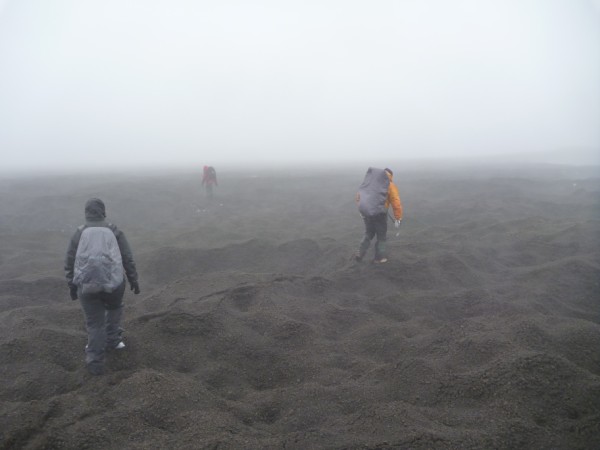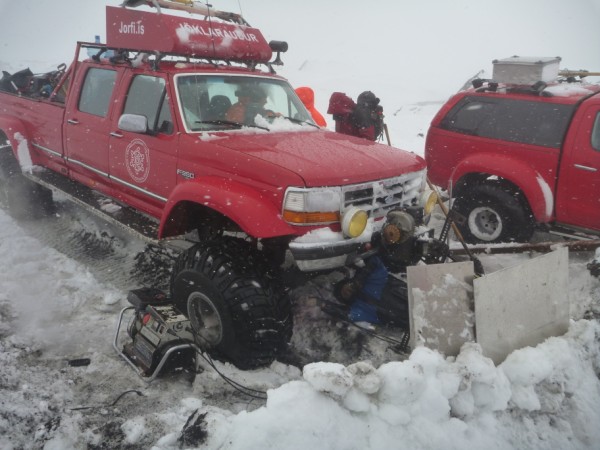Last month, the Institute of Earth Sciences of the University of Iceland and the Iceland Glaciological Society organised an expedition to Grímsvötn to study the deposits of the eruption that took place there in May. This post describes some of the difficulties in working on the debris-covered glacier. There are other posts describing the adventurous journey up to the volcano (Grímsvötn 1 – Crossing the glacier), and the huge volume of material produced during the eruption (Grímsvötn 2 – What was in the plume?).
Hiking in the clouds
The journey across the glacier had been slow, as patchy cover of volcanic-debris and uneven melting had created a maze-like landscape of ridges and platforms on the surface of the glacier. It was decided that the best way to get to the interesting geology would be to hike the 5 km from the huts. The cloud was down, it was 2 degrees C, damp and windy. The loose pumice and ash were soft underfoot. Visibility was 20-100 m and navigation on the featureless terrain was by GPS. The hike took 3 fairly-miserable hours in each direction.

It was decided that the best way to get to the interesting geology would be to somehow get the trucks through to where the surface was more continuous.
Building a road
The following afternoon, a ‘road’ was constructed. Narrow ridges were dug through, holes were filled with snow, sharp edges on walls were softened to form ramps. It was hard work. Fortunately, the definition of ‘road’ for these trucks is quite broad.

The road meant the we could get to the interesting region in 1.5 hours, and arrive dry and warm, ready to work. We could also move quickly between sites where the surface was smooth. We used it for the following days, and scenes like the one below became almost routine.

Welding in a blizzard
During the days that we worked on the glacier, the snow was melting. By the time we were ready to leave, it had lost about 10 cm, weakening the snow bridges that we had used to cross crevasses on our way up. On the homeward journey, a bridge collapsed beneath the front left tire of the big Ford F350 and it dropped to its belly. We couldn’t get it out using the jack alone (as we had done previously) so the Hilux came round and winched it out. A close look showed that the axle had been broken. We had a spare, so it was changed there and then.
Further inspection showed that part of the suspension had been damaged, too. It turns out that we also had a generator and welding equipment, so that was fixed there and then as well. On a glacier, in a blizzard, in less than two hours. It takes a week to get an appointment for the annual MOT test at my local garage! It seems that a mechanic is top of the list of things to bring on this type of expedition.
Bridging the crevasse
To finally cross the crevasse, it was ‘bridged’ with wooden planks, which spread the weight of the truck across a wide area of snow. The same principle allows a skier to cross snow bridges that a hiker would fall through. Once out of the crevassed area, the return journey was straightforward, but slow. We reached the edge of the glacier 12 hours after setting off.

The outward journey to Grímsvötn is described in the post Grímsvötn 1 – Crossing the glacier, and there are descriptions of the results of the eruption itself in Grímsvötn 2 – What was in the plume?



